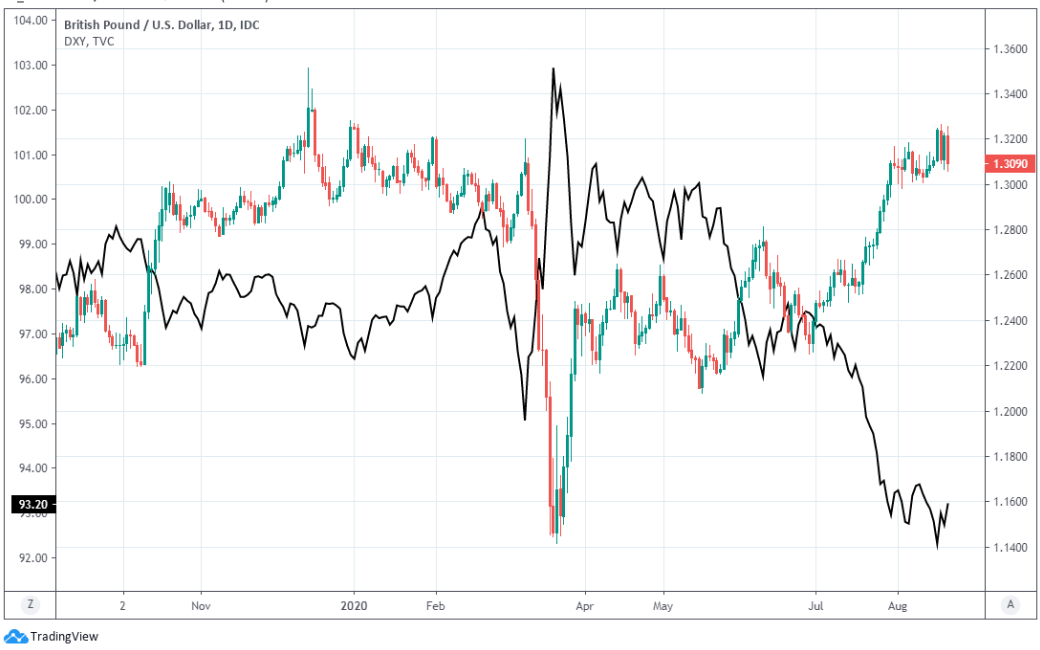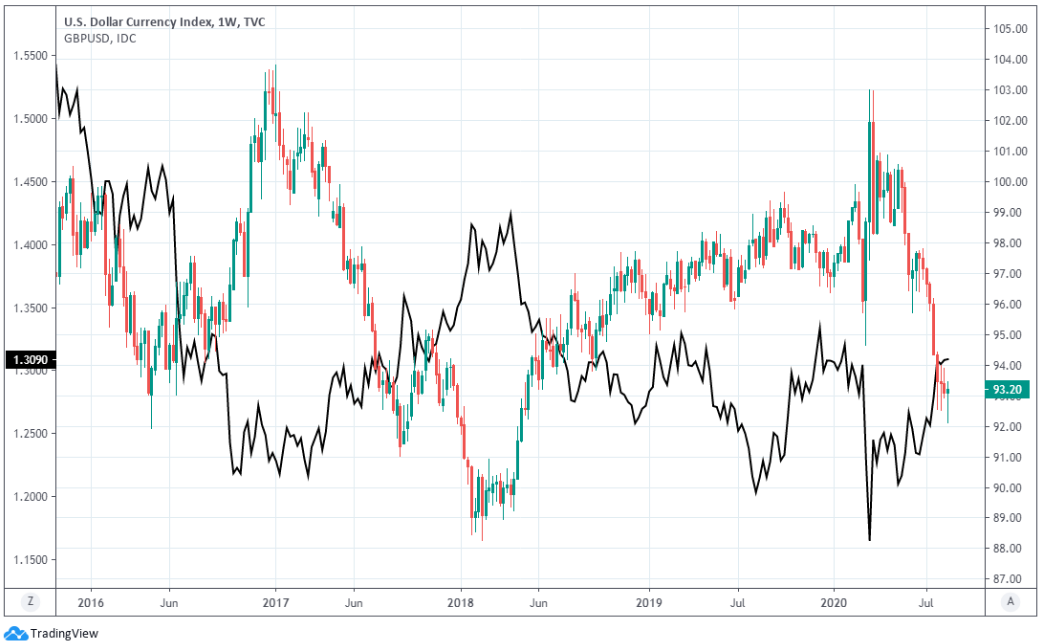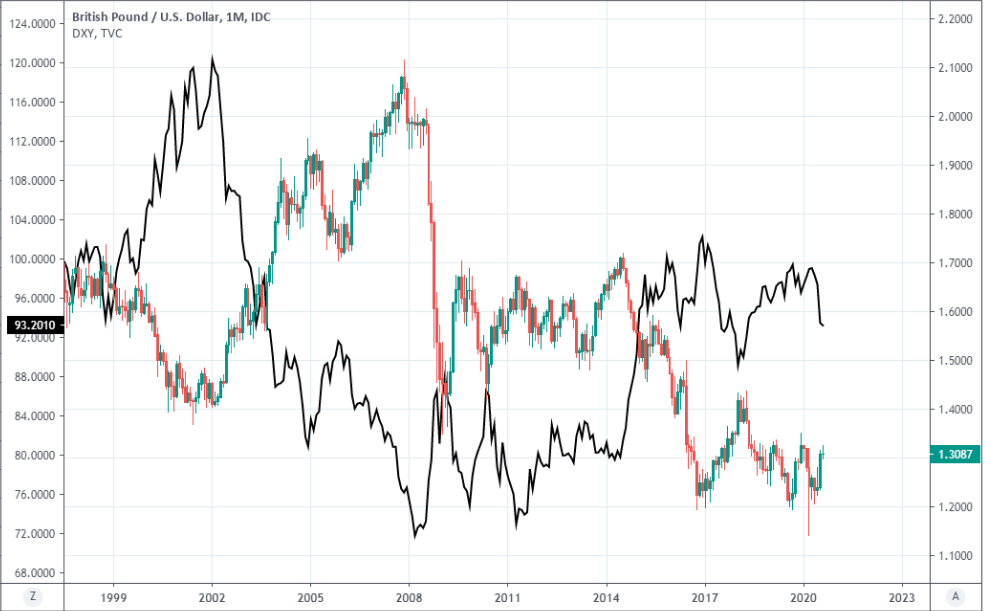Pound-Dollar Week Ahead Forecast: Charts Warn of Further Weakness as Analysts Look for USD Rebound
- Written by: James Skinner
-
- GBP/USD now vulnerable after capitulation at 2020 high.
- Charts warn of a retracement as far back as 1.27-to-1.28.
- Republican Convention could prompt market volatility
- As analysts tip USD correction ahead of key Fed speech.

Image © Adobe Images
- GBP/USD spot rate at time of writing: 1.3083
- Bank transfer rate (indicative guide): 1.2731-1.2823
- FX specialist providers (indicative guide): 1.2893-1.2971
- More information on FX specialist rates here
The Pound-to-Dollar exchange rate signed off with a soft finish to an otherwise strong week on Friday and could see further losses over the coming days, according to a range of analysts who see the greenback correcting higher ahead of an important speech from Federal Reserve Chairman Jerome Powell.
Pound Sterling ended third placed in the performance rankings among major currencies last week after ceding ground to only the Japanese Yen and Canadian Dollar while clocking up an almost-half percent gain over the Dollar.
Friday saw French and Eurozone PMI surveys slump in a market disappointment that proved pivotal to the trajectory of the major exchange rates ahead of the weekend, while weakness in the German services sector added to the glum mood that sent EUR/USD lower and the Dollar Index higher.
Sterling was less impacted by the resulting weakness in European currencies thanks to upside surprises in both manufacturing and services for what was the first month in which the UK economy was almost fully reopened throughout, although a downbeat update from Brexit negotiators sent the Pound tumbling.
"Although most USD selling has been against the EUR, the USD has weakened across the board, while the EUR has remained broadly stable against non-USD currencies. The USD move has been correlated with the strong rebound in risk assets since March," says Athanasios Vamvakidis, head of FX strategy at BofA Global Research. "Despite spot having rallied with other G10 currencies against USD, median GBPUSD forecast for Q4 2020 did not materially return to the level at beginning of the year. Higher forecast volatility for GBPUSD also reflect the uncertainty in post-Brexit trade deals and dismal economic outlook."
A quiet economic calendar could mean the gloom kicked up by this data hangs in the air early in the new week, enabling the oversold greenback to carve out a short-term bottom in the wake of two months of losses.
Above: Pound-to-Dollar rate shown at daily intervals alongside Dollar Index (black line, left axis).
Eurozone PMIs contradict the dominant prevailing narrative of a continental economic outperformance of the U.S., which is thought to have been instrumental in driving the recent sell-off in U.S. exchange rates.
Add to that a swelling second wave of coronavirus in Europe and the ingredients for a Dollar correction could be on the table.
This, combined with renewed Brexit worries could be enough to deprive the Pound-to-Dollar rate of another attempt at last week's 2020 high around 1.3265. In other words, the Pound may be past its best for the time being.
Technical analysts are now reverting their attention to the downside and a line of possible supports for the Pound on the charts.
"The new high of 1.3268 has been accompanied by a divergence of the daily RSI and this is coupled with a 13 count. We also have warning signals on the intraday charts and suspect that we will see a corrective dip," says Karen Jones, head of technical analysis for currencies, commodities and bonds at Commerzbank. "Below 1.3284 we would allow for a deeper slide to the 1.2814 June high and possibly the 1.2706 support."
Jones sold the Pound at 1.3231 and has advocated that clients look for a fall to a take-profit level of 1.2975 ahead of a further decline to 1.2825, where she intends to exit her trade.
Commerzbank anticipates short-term technical corrections in many Dollar pairs but says the outlook for Sterling will remain positive so long as it holds above 1.2072.
Above: Pound-to-Dollar rate shown at weekly intervals alongside Dollar Index (black line, left axis).
If you would like to book in an exchange rate around current levels for use at a future date to protect your international payments budget, or would like to automatically book a higher or lower rate should it be achieved, we would suggest investigating the tools at your disposal.
"The case for structural Dollar weakness remains intact, in our view. The currency is overvalued, US real rates will likely remain deeply negative for a number of years, and the global economy should be on a steady upward path out of the coronavirus recession. This is a standard recipe for sustained Dollar weakness. However, over the next few weeks recent consolidation may continue, due to uncertainty around Covid control, the Fed policy outlook, and US politics," says Zach Pandl, global co-head of foreign exchange strategy at Goldman Sachs.
"The Republication National Convention this week could support the Dollar if it results in a tightening of the polls - a view that a Biden Administration would raise U.S. corporate tax rates has likely weighed on the greenback - or if President Trump makes major new announcements on U.S. policy toward China. Investors with relatively short horizons should consider scaling down USD shorts until these events have passed," adds Pandl.
It's not just the charts tipping a correction in major exchange rates because a wide range of analysts are warning of a Dollar rebound including those who hold bearish medium-term views on the greenback while forecasting resilience or otherwise further gains from Sterling and other currencies in the months ahead.
"The USD sell-off of late looks excessive and some correction stronger appears warranted. But we’d expect any strength to be modest and short-lived given the risks on the horizon including the potential for US equity market under-performance," says Lee Hardman, a currency analyst at MUFG. "The outperformance of the US equity markets has been primarily down to ‘big tech’ and we see increasing risks of the equity market outperformance reversing which we believe is ultimately a negative for the US dollar."
The economic calendar is devoid of major data although from mid-week onward market attention will turn to the annual Jackson Hole Symposium where Federal Reserve Chairman Jerome Powell and Bank of England Governor Andrew Bailey are both expected to speak about monetary policy.
Above: Pound-to-Dollar rate shown at monthly intervals alongside Dollar Index (black line, left axis).
"Governor Bailey won't escape Jackson Hole without addressing questions around negative rates. The MPC approved negative rates as a credible policy tool at the August meeting but remained hesitant on using further rate cuts in the near future. Governor Bailey will likely reiterate this view. We ourselves don't see negative rates or further rate cuts happening this year. But depending on the economy's progress, rate cuts could become more of a talking point next year when the banking environment may be better and the MPC has a better view of slack in the UK economy. For now, the upward surprises in data—both activity (Q2 GDP, June GDP, July retail sales) and inflation—should keep policy unchanged with the Governor sounding broadly neutral on the policy outlook," says Sanjay Raja, an economist at Deutsche Bank.
Chairman Powell will address an audience around 14:10 Thursday and while its 'framework review' and increasingly "symmetrical" view of the inflation target are a likely focus of the market, and a Dollar-bearish one, the long-term implications of the coronavirus crisis for the bank's monetary policy toolbox.
The unprecedented amounts of new money created to fund extraordinary policy supports for the economy could forever have changed the way the Fed combats crises and in a manner that sees future balance sheet expansions working their way more effectively and directly into the real economy.
From corporate bond purchases to government bond buys that are closely coordinated with Treasury fiscal plans, the Fed's new policy bag is a Dollar bearish one and should Powell delve into this subject on Thursday then he might ensure a soft finish to the week for the greenback
The same is true of other central banks including the Bank of England (BoE), which has despatched Governor Andrew Bailey to Jackson Hole where he'll address an audience around 14:05 Friday. Sterling will be listening keenly for clues about how the BoE's policy stance could change in the months ahead.








